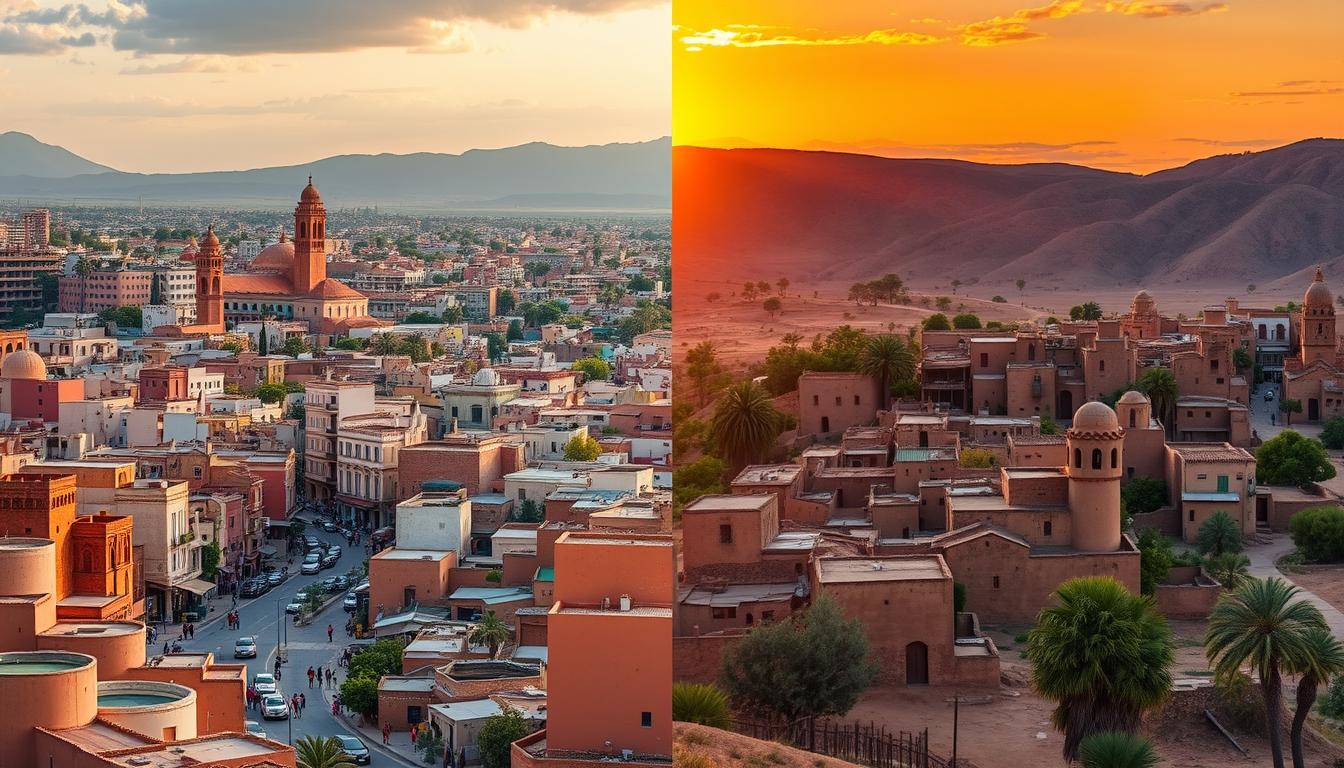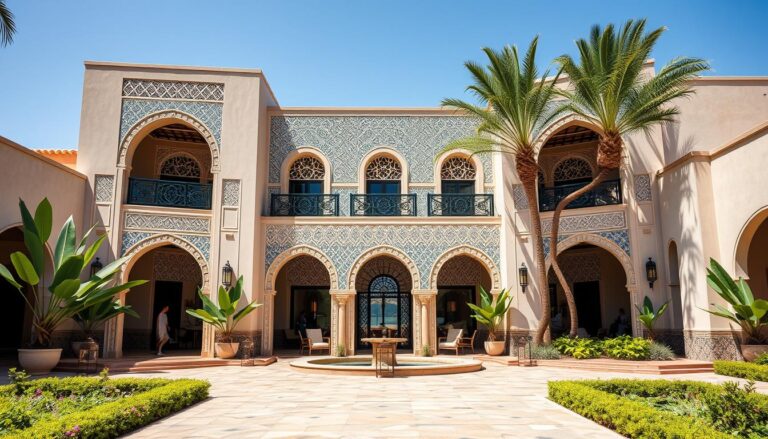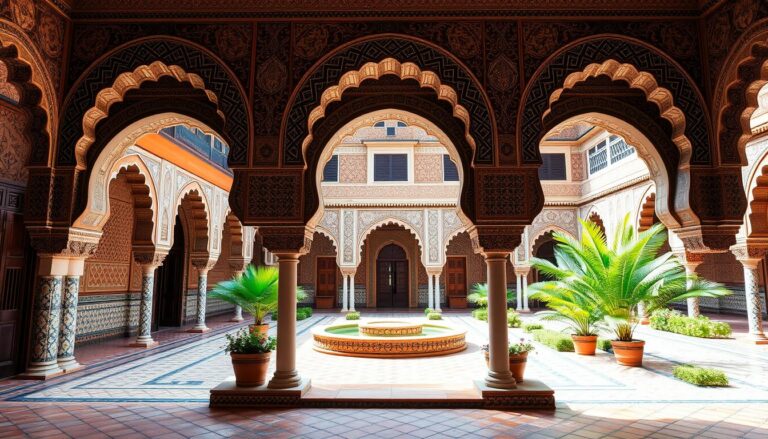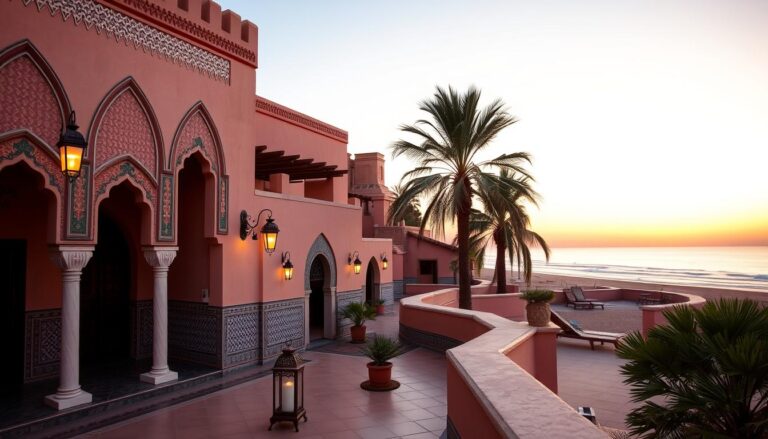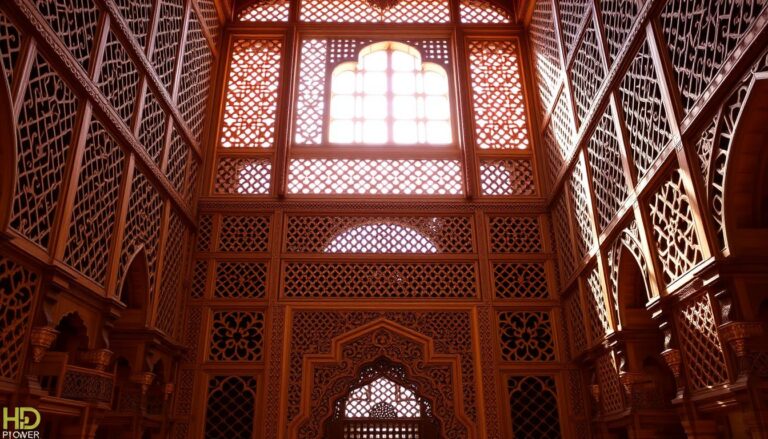Morocco’s architecture shows a clear difference between city and countryside. The Atlas Mountains are home to ancient Berber kasbahs. Meanwhile, Marrakesh boasts stunning Moorish palaces. These places show how Morocco’s architecture is shaped by many influences and local needs.
But what makes these styles unique? How do they help shape Morocco’s culture? Let’s explore the rich world of Moroccan architecture. We’ll see how city and countryside styles work together.
Key Takeaways
- Moroccan architecture is a tapestry of diverse influences, including Amazigh (Berber), Islamic, Moorish, and colonial styles.
- Traditional rural architecture in Morocco, particularly in the Atlas Mountains and Sahara, features structures like kasbahs and ksour made of rammed earth and local materials.
- Urban Moroccan architecture is marked by the Moorish or western Islamic style, incorporating intricate tilework, geometric patterns, and open courtyards.
- Vernacular architecture in Morocco has evolved to adapt to local climates and utilize sustainable construction techniques.
- Modern Moroccan architecture balances tradition and innovation, with architects like Driss Kettani leading the way in integrating sustainable design and preserving cultural heritage.
Introduction to Moroccan Architecture
Morocco’s buildings are a mix of many styles, showing its deep history. You can see ancient Roman sites, Islamic designs, local styles, French buildings, and modern ones. This mix makes Morocco’s architecture truly unique.
Diverse Influences and Rich Heritage
Morocco’s buildings come from many cultures. There’s the Amazigh (Berber) culture, pre-Islamic Spain, the Islamic Middle East, and European influence. This mix has created a special Moroccan style that blends diverse architectural influences beautifully.
Blending of Berber, Islamic, Moorish, and Colonial Styles
Moroccan architecture is special because it combines Berber, Islamic, Moorish, and colonial styles. This architectural blending makes a design that shows Morocco’s rich heritage and cultural history.
“The architecture of Morocco is a testament to the nation’s ability to seamlessly integrate diverse cultural elements into a cohesive and visually striking whole.”
Moroccan architecture is full of beauty. You’ll see big Berber kasbahs, detailed Islamic patterns, and beautiful Moorish tiles. It shows the country’s diverse architectural influences and rich heritage. It’s a sight that draws in visitors and scholars, giving them a peek into Morocco’s lasting cultural impact.
Berber Influences on Rural Architecture
Moroccan Amazigh (Berber) architecture is unique to the Atlas Mountains and Sahara. These areas are filled with kasbahs (fortresses) and ksour (fortified villages). They show the local geography and social structures, like Ait Benhaddou.
These structures are built with rammed earth and feature local geometric designs. They have adapted Islamic architecture to fit their needs over centuries.
Kasbahs and Fortified Villages
The kasbahs and ksour are more than just fortifications. They also show the social and cultural traditions of the local communities. These structures were built to protect, shelter, and unite people in the Atlas Mountains and Sahara.
Use of Rammed Earth and Local Materials
Berber architects in rural Morocco used local materials like rammed earth for their buildings. This method was sustainable and blended well with the landscape. It also showed the Berber people’s ability to adapt to their environment.
“Moroccan Berber architecture is a testament to the resilience and creativity of the indigenous people, who have woven their cultural traditions into the very fabric of their built environment.”
Islamic Architectural Elements
Morocco’s traditional architecture is deeply rooted in the Islamic style. This style emerged in the 7th century and blended various influences. It includes the Amazigh (Berber) culture, pre-Islamic Spain, and the Islamic Middle East.
Over time, it developed unique features. These include the horseshoe arch, riad gardens, and intricate geometric and arabesque motifs. These are found in wood, carved stucco, and zellij tilework.
Geometric Patterns and Arabesque Motifs
Colorful tiles and intricate geometric patterns are key in Moroccan Islamic architecture. These patterns, often seen in zellij tilework, reflect the country’s rich artistic and spiritual heritage. They are a cornerstone of Moroccan design principles.
Mosques, Madrasas, and Riads
Some of the most iconic examples of Islamic Moroccan architecture are the al-Qarawiyyin and Andalusiyyin mosques in Fes. The Almohad Kutubiyya Mosque in Marrakesh is another notable example. These structures highlight the country’s Islamic architectural legacy.
Additionally, Morocco is home to the Menara and Agdal Gardens. These garden estates are a testament to the tradition of establishing such spaces. Moroccan madrasas, like the Medersa Bou Inania in Fez, and unique courtyard houses known as riads, also showcase the country’s Islamic architectural heritage.
“Moroccan Islamic architecture stands out for its intricate geometric and arabesque motifs created using zellij tilework, wood, and carved stucco.”
Moorish Influences and Urban Styles
Moroccan architecture is famous for its Moorish touches. These can be seen in the unique urban styles across the country. The Moorish style, coming from the Maghreb and Muslim Spain, is known for white stucco, detailed tilework, and beautiful courtyards and gardens.
Stucco Facades and Intricate Tilework
The Almoravids and Almohads, two big Berber empires, helped shape Moroccan architecture. They built cities like Marrakesh and Rabat. They introduced features like tall minarets, fancy gateways, and zellij (mosaic tilework) with cool patterns and designs.
Courtyards and Gardens
Traditional Moroccan buildings focus on what’s inside, not the outside. Many old houses, called riyad or riad, have central courtyards or gardens. These wast ad-dar (central patios) show the owner’s status and wealth. They offer privacy, security, and beauty with greenery and water.
“The size and craftsmanship of the central patio/courtyard, the wast ad-dar, was a symbol of the status and wealth of the owners, rather than the house’s external appearance.”
The Moorish influence on Moroccan urban architecture shows the country’s rich culture and lasting architectural traditions.
Urban vs. Rural Architectural Styles in Moroccan Architecture
Moroccan architecture is a fascinating mix of cultures and traditions. Cities like Marrakesh show off Moorish beauty with white walls, detailed tiles, and central courtyards. But, the Atlas Mountains and Sahara Desert reveal the traditional Berber styles.
Contrasting Approaches to Design and Materials
In cities, Moroccan architecture is all about grand designs and materials like plaster, stone, and tiles. But, in the countryside, things are simpler. Rammed earth, stone, and local materials are used to fit right into the landscape.
Adaptation to Local Environments and Traditions
Rural Berber buildings are made to withstand the desert’s harsh weather. Kasbahs and ksour protect people and keep traditions alive. This is different from the ornate, city-focused Moorish styles, shaped by history and modern materials.
Moroccan architecture shows the country’s rich history and people’s ability to adapt. They keep their traditions alive, even as their surroundings change.
“Preservation of vernacular architecture is crucial for the preservation of Moroccan building traditions.”
Colonial and Contemporary Influences
Morocco’s buildings show a mix of cultures, from colonial times to today. The French rule from 1912 to 1956 brought new styles. They mixed French Art Deco with Moroccan designs, creating the Mauresque style seen in Rabat and Casablanca.
The French also set rules for buildings, like flat roofs and limits on height. These rules helped keep traditional styles but slowed down city growth. After gaining independence, Morocco saw a surge in new architectural ideas. These designs honored the past but also looked to the future.
French Colonial Architecture and Mauresque Style
The French attack on Casablanca in 1907 destroyed much of the city. The French Protectorate, starting in 1912, divided Casablanca into areas for Moroccans and Europeans. Architects like Marius Boyer built in Art Nouveau and Art Deco in the European part until the 1930s.
Modern Interpretations and Innovations
After gaining freedom, Morocco’s buildings kept traditional touches but also showed modern styles. The Mausoleum of King Mohammed V and the Hassan II Mosque in Casablanca are examples. Architects like Elie Azagury introduced Brutalist architecture, showing Morocco’s architectural growth.
“At the 1953 International Congress of Modern Architecture, the Groupe des Architectes Modernes Marocains (GAMMA) emphasized considering local culture and climate in modernist architectural designs.”
Today, Morocco’s buildings mix old and new beautifully. This mix shows the country’s rich history and its ongoing development.
Conclusion
Moroccan architecture shows the country’s rich cultural mix. It combines Berber, Islamic, Moorish, and colonial styles. This blend creates a unique and fascinating design landscape.
From the grand kasbahs in rural areas to the detailed mosques and riads in cities, Moroccan architecture is diverse. It has evolved over centuries, keeping the country’s history alive.
Even with new designs, Morocco’s old architecture still shapes its cities and towns. As cities grow, they must keep their cultural heritage. This is crucial for Morocco’s future.
In the end, Moroccan architecture is a symbol of the country’s strength and cultural richness. It beautifully mixes old and new, inspiring all who see it.
Source Links
- Moroccan architecture
- Moroccan Architecture: In-Depth Review of Styles in Morocco
- An Exploration of Modern Moroccan Architecture – The Yale Globalist
- Seismic performance of traditional urban architecture in Morocco
- Historic house architecture in Morocco
- An Architectural review of Chefchaouen, Morocco
- Morrocan Culture: A Vibrant Tapestry of Influences – Eltoro Hotel
- Travel Morocco – Moroccan Heritage & People
- Exploring the Timeless Beauty of Moroccan Architecture | African Sahara
- Architectural Wonders of Morocco – Rahtours
- Traditional Architecture in Morocco
- From Islamic to Art Deco: A rich history of Moroccan architecture
- Urban Identity Explored: Architecture and Arts in Cities
- Proceedings of the GSAP 2006 Colloquium
- Architecture of Casablanca
- How Moroccan Architecture Reflects Cultural and Historical Influences
- Architectural and Urban Communication in Social Identity: The Case Study of Agadir Morocco: From Colonial Preponderance to Renaissance Which Social Identity
- Learning from the douar. Michel Écochard and the modern invention of the semi-rural Moroccan habitat
- Youth Perceptions and Constructions of Urban Space in Morocco
- Tradition and Sustainability in Vernacular Architecture of Southeast Morocco

The Editorial Team is a passionate group of Morocco enthusiasts dedicated to sharing the beauty, culture, and wonders of this captivating country. With diverse backgrounds and a deep love for travel, we strive to bring you engaging and informative content that inspires your Moroccan adventures. From uncovering hidden gems and sharing local insights to exploring mouthwatering cuisine and showcasing the vibrant lifestyle, our team is committed to providing you with valuable resources and exciting stories that enhance your exploration of Morocco. Join us on this journey as we celebrate the rich heritage and unforgettable experiences that make Morocco truly special.

